Tag: planting
Leaflet: It’s Time To Put Down Some Roots
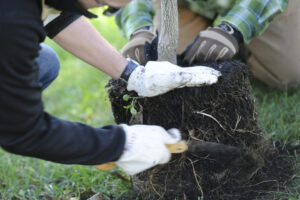
Last month, we told you why you should leave the leaves. We got such great feedback that we decided to create a regular tree care column, Leaflet, so that our eager experts can pass on their knowledge. We’ll share best practices for tree care and maintenance, explore common myths and misconceptions, and dig into the science behind it all.
“Now that the leaves are on the ground, we get busy,” says Neighborhood Trees Senior Specialist Drew Land about the November tree planting season. “Speaking of busy, roots are always busy.” We plant trees now so that while the trees are dormant above ground, they can focus on establishing their roots below ground. From timing to mulching to watering, our strategies help shape the tree’s root system.
“Street trees are not truly part of the urban forest until their roots start to intermingle,” Drew says. That’s why making sure a tree’s roots get established properly is a crucial part of planting and maintenance.
Because roots are almost entirely underground, we don’t really think about the shape of their structure. Rather than just a main tap root that goes straight down, 85% of a tree’s roots are within the top 24 inches of soil, or at least they should be. In the urban environment, roots are often up against the challenge of compacted and nutrient-depleted soil. In situations like these, roots will be too shallow, because they don’t have the space to seek out water and oxygen. Trees in the forest enjoy uncompacted soil with plenty of air and water spaces below ground. This also gives room for the fungal and microbial activity that brings soil to life.
“Roots are opportunists,” Drew says. “They follow the resources.” Given the right moisture and temperature, tree roots can grow year round. Insulation from mulch maintains those conditions, and we spread it in a way that encourages the roots to grow outward. Similarly, we shouldn’t just water at the base of a tree’s trunk, but should aim to water the tips of roots as they grow outward from the trunk. And we should water long enough that it sinks beyond the surface. Deep, infrequent watering mimics natural rain storms and gives roots what they need to spread both outward and downward. “Well-meaning people often shallow water on a daily basis, but that only feeds grass/weeds and not the tree roots a foot below. “
Tree roots come in two main types: structural roots and feeder roots. Structural roots are woody, and serve as the architecture to keep the tree upright. Feeder roots, which are much more like root hairs, are in charge of absorbing water and nutrients.
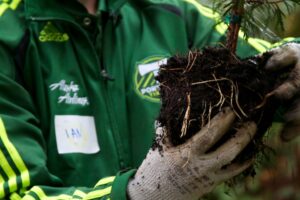
Maybe you have heard the myth that tree roots can grow into your sewer or water pipes and bust them open. Drew is here to officially bust that myth. He says that while roots are opportunistic, they are not invasive. “So the roots are not busting your sewer line,” he promises. “Your line is already busted and the roots found a tasty water source.”
Recreating ideal natural conditions is the best way to ensure that the roots of our urban trees stay healthy. “Roots are like muscles,” Drew says. “They grow in response to stress.” When you tie a newly planted tree too tightly to a support, it won’t have the freedom to move in the wind, building up those root “muscles” to support itself.
Getting the roots established is one of the most important reasons we plant new trees in the fall. “Planting trees now, while they’re dormant, will build their resilience,” Drew says. ”In ten months, when autumn winds hit their leaves for the first time, they’ll be ready.”
Further reading:
- “Roots Demystified” by Robert Kourik
- “Up by Roots” by Jim Urban
Get to know our partner: Wisdom of the Elders
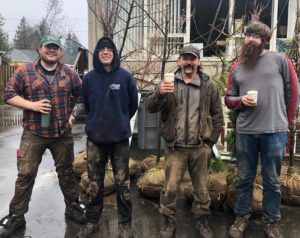
“Partnering with Friends of Trees has helped teach Wisdom interns management skills; we learn how to manage a business, how to engage with business people, it prepares everybody for employment.” – Alvey Seeyouma, Wisdom Workforce Development Program Coordinator and Crew Leader Supervisor
The Wisdom of the Elders-Friends of Trees partnership began four years ago when our Neighborhood Trees Program needed some post-planting help. We had a number of street trees that didn’t get planted at a Saturday planting event and we were able to contract with Wisdom Workforce to plant those trees.
Soon after that first partnership experience, Wisdom hosted a community conversation for its partners, toward sharing information about how best to partner together in a way that is thoughtful and respectful. We participated in a Talking Circle, where there was honest communication about the native perspective on the dominant culture and environmental issues.
The partnership grew, and Wisdom’s post-planting support evolved to include mulching newly planted trees. Wisdom participants also began engaging on planting day, through training and participating as Crew Leaders, which provided opportunities for the organizations to work together more closely. We’ve now added pruning as a partnership element, providing even more hands on tree care experience.
Wisdom Workforce Program Coordinator Alvey Seeyouma participated in the Urban Forestry Training Program and, through that program, interned with Friends of Trees. Alvey says that the benefits of the partnership extend beyond Friends of Trees and Wisdom of the Elders, “Oh my gosh, I think our partnership benefits all communities. It helps the Wisdom crew leaders become more comfortable with their engagement with the community, so it benefits everyone.” He lists some more benefits of the partnership, “Wisdom interns are learning new skills through the community tree planting events. They’re learning about tree identification, planting techniques, and about community engagement through training as Crew Leaders.”
What would Alvey want folks to know about Friends of Trees? “Friends of Trees is a great organization. Everyone in the office, they’re so helpful, so kind and generous. They want everyone’s experience to be positive; they’ve offered so much training, which we are so grateful for.” Friends of Trees is equally grateful for the opportunity to enhance our organization and our community tree planting events through partnering with Alvey and everyone at Wisdom of the Elders.
Wisdom of the Elders records and preserves traditional cultural values, oral history, prophesy and other messages of guidance from indigenous elders in order to regenerate the greatness of culture among today’s and future generations of native peoples. Learn more at www.wisdomoftheelders.org
Pictured above: Matt, Bruce, Dave and Will of Wisdom of the Elders at a recent SE Portland tree planting event.
This story is from the January 2020 edition of our e-news, Treemail; check out other issues of Treemail here.
We need to do something bigger than ourselves.
“We need to do something bigger than ourselves.”
– Mohamed, Friends of Trees volunteer since 2014
Mohamed and his wife Farah, and their children and friends, have planted hundreds of trees with us in memory of their daughter, Ayan. Farah very candidly shares why, “Every tree that we plant I feel like it’s for her. And I think about all of the benefits that all these trees will produce … it keeps on giving. It’s a way of sharing her with the world.”
This beautiful video shares the story about why Mohamed, Farah, and their family plant trees together in honor of Ayan:
“When you are outdoors and in nature you tend to forget whatever problems you may have. When you go into nature with others and look at the beauty, how big things are … it has that healing process.” -Mohamed
The more than 50,000 trees and shrubs we plant every year with so many community volunteers transform neighborhoods and natural areas. Trees clean our air and water, cool the planet, provide habitat—and can help us feel better. There are many examples of how trees improve our health; just the act of planting a tree can be personally transformative; digging in the dirt with the hope and intent of something taking root just feels good.
It’s about trees and it’s about community. When we come together to plant trees we are doing something good, we’re making a difference and we’re making our world a better, more welcoming place.
There is so much we can do that is bigger than ourselves. Donating to Friends of Trees’ programs that plant trees and grow community will help our planet and its inhabitants for generations to come. As Mohamed also shared, “Planting trees really will outlive us. The effort that you put is so small, the benefit is just gigantic.”
Thank you for the gigantic act of supporting trees + community. We look forward to planting trees with you!
Trees & Health Symposium in Gresham on Nov 13
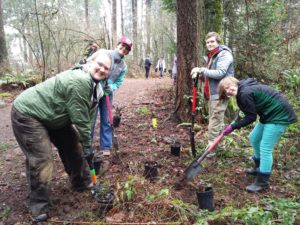
We all know that trees provide benefits to people and the communities they live in.
But do you know how to care for trees to help them thrive, and how you can add to Gresham’s tree canopy at home or in your neighborhood?
The Gresham Trees and Health Symposium will feature a mix of speakers, film, discussion, tree care booths, light refreshments, and a summary of the City’s Green Gresham, Healthy Gresham tree project in Rockwood.
Wednesday, November 13, 2019
6:00 – 8:00 PM, Rockwood Boys & Girls Club
More information and registration information is here, thank you to our co-hosts Multnomah County and City of Gresham!
Get to know our partner: the City of Vancouver
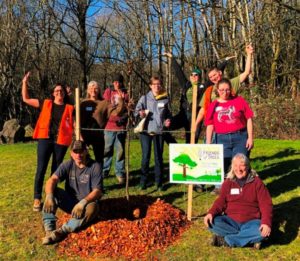 “Friends of Trees does more than simply plant a tree at a Vancouver resident’s house. They plant the right tree, the right way, in the right location.” -Charles Ray, City of Vancouver Urban Forester
“Friends of Trees does more than simply plant a tree at a Vancouver resident’s house. They plant the right tree, the right way, in the right location.” -Charles Ray, City of Vancouver Urban Forester
For 16 years Friends of Trees has been planting the right trees, the right way, for Vancouver residents in partnership with the City of Vancouver. Currently more than 500 trees are planted every year here, thanks to the help of hundreds of community volunteers.
Vancouver’s Urban Forester, Charles Ray, reflects on this long-lasting, impactful partnership, and the important role trees play in the community,
“Vancouver has a long history with trees and considers trees community assets that provide multiple benefits, including clean water. The simple truth is trees in the community have practical, quantifiable values and are not merely decorations. They provide essential benefits that we cannot live without.
“We are fortunate to have an organization like Friends of Trees that shares the same mission and helps us accomplish more. Most municipal programs across the country dream of having an opportunity such as this. Friends of Trees does more than simply plant a tree at a Vancouver resident’s house. They plant the right tree, the right way, in the right location.
“Friends of Trees engages that person several times through the process, enabling staff and volunteers to share the benefits of trees and educate them about the City’s processes and requirements around trees. It also offers them an opportunity to engage hands-on with the community asset, the tree that will be planted in front of their house. This often leads to stronger community connections and civic involvement, and knowledge of the benefits, how to care for and needs of the urban forest.
“Planting the right tree in the right place and giving it the right care and pruning make all the difference to ensuring a healthy urban forest today and for generations to come. It only takes a minute to improperly prune or remove a tree but a lifetime to grow one.
“We cannot do it alone. I am excited by Friends of Trees’ commitment to Vancouver and the community’s efforts to meet this need. If I could ask for one thing it would be participation from the business community to sponsor plantings so that we can increase our annual planting goals with Friends of Trees.”
Charles, we couldn’t say it better ourselves; Vancouver businesses, join us!
Pictured above: Far left, Jessica George, City of Vancouver; standing, third from left, UF Program intern Bruce
This is from the April 2019 edition of our e-news, Treemail; check out that issue of Treemail, and others, here.

